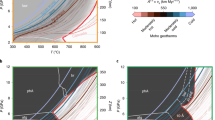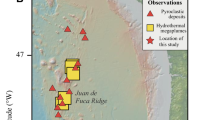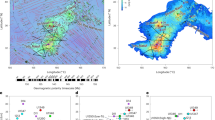Abstract
Hydrothermal megaplumes are huge volumes of anomalously warm water that are located up to 1,000 metres above the sea floor and appear to be generated at mid-ocean ridges. Since their discovery in 1986, there has been considerable debate concerning their origin. A theoretical model is used to argue that the cooling of pillow basalts, which are erupted at ∼1,200 °C into sea water and are the most common form of submarine volcanic activity, is responsible for the megaplume formation.
This is a preview of subscription content, access via your institution
Access options
Subscribe to this journal
Receive 51 print issues and online access
$199.00 per year
only $3.90 per issue
Buy this article
- Purchase on Springer Link
- Instant access to full article PDF
Prices may be subject to local taxes which are calculated during checkout


Similar content being viewed by others
References
Baker, E. T., German, C. R. & Elderfield, H. in Seafloor Hydrothermal Systems (eds Humphris, S. E., Zierenberg, R. A., Mullineaux, L. S. & Thomson, R. E.) 47–71 (Geophys. Monogr. 91, Am. Geophys. Union, Washington DC, (1995)).
Baker, E. T., Lavelle, J. W., Feely, R. A., Massoth, G. J. & Walker, S. L. Episodic venting of hydrothermal fluids from the Juan de Fuca Ridge. J. Geophys. Res. 94, 9237–9250 (1989).
Cann, J. R. & Strens, M. R. Modelling periodic megaplume emission by black smoker systems. J. Geophys. Res. 94, 12227–12237 (1989).
Cathles, L. M. Acapless 350 °C flow zone model to explain megaplumes, salinity variations, and high temperature veins in ridge axis hydrothermal systems. Econ. Geol. 88, 1977–1988 (1993).
Wilcock, W. S. D. Amodel for the formation of transient event plumes above mid-ocean ridge hydrothermal systems. J. Geophys. Res. 102, 12109–12121 (1997).
Lowell, R. P. & Germanovich, L. N. Dike injection and the formation of megaplumes at ocean ridges. Science 267, 1804–1807 (1995).
Baker, E. T., Massoth, G. J. & Feely, R. A. Cataclysmic hydrothermal venting on the Juan de Fuca Ridge. Nature 329, 149–151 (1987).
Lavelle, J. W. & Baker, E. T. Anumerical study of local convection in the benthic ocean induced by episodic hydrothermal discharges. J. Geophys. Res. 99, 16065–16080 (1994).
Nojiri, Y., Ishibashi, J., Kawai, T., Otsuki, A. & Sakai, H. Hydrothermal plumes along the North Fiji Basin spreading axis. Nature 342, 667–670 (1989).
Gamo, T. et al. Hydrothermal plumes in the eastern Manus Basin, Bismark Sea: CH4, Mn, Al and pH. Deep-Sea Res. 40, 2335–2349 (1993).
Baker, E. T. et al. Hydrothermal event plumes from the CoAxial seafloor eruption site, Juan de Fuca Ridge. Geophys. Res. Lett. 22, 147–150 (1995).
Butterfield, D. A. et al. Seafloor eruptions and evolution of hydrothermal fluid chemistry. Phil. Trans. R. Soc. Lond. A 355, 369–386 (1997).
Chadwick, W. W. & Embley, R. W. Lava flows from a mid-1980s submarine eruption on the Cleft segment, Juan de Fuca Ridge. J. Geophys. Res. 99, 4761–4776 (1994).
Rosenberg, N. D., Spera, F. J. & Haymon, R. M. The relationship between flow and permeability field in seafloor hydrothermal systems. Earth Planet. Sci. Lett. 116, 135–153 (1993).
Höskuldsson, A. & Sparks, R. S. J. Thermodynamics and fluid dynamics of effusive subglacial eruptions. Bull. Volcanol. 59, 219–230 (1997).
Carslaw, H. S. & Jaeger, J. C. Conduction of Heat in Solids 2nd edn (Oxford Univ. Press, (1959)).
Turcotte, D. L. & Schubert, G. Geodynamics, Applications of Continuum Physics to Geological Problems (Wiley, New York, (1982)).
Huppert, H. E. & Sparks, R. S. J. Melting of a chamber containing a hot turbulently convecting fluid. J. Fluid Mech. 188, 107–131 (1988).
Walker, G. P. L. Morphometric study of pillow-size spectrum among pillow lavas. Bull. Volcanol. 54, 459–474 (1992).
Embley, R. W., Chadwich, W., Perfit, M. R. & Baker, E. T. Geology of the northern Cleft segment, Juan de Fuca Ridge: Recent lava flows, sea-floor spreading and the formation of megaplumes. Geology 19, 771–775 (1991).
Thórarinsson, S. On the rate of lava and tephra production and the upward migration of magma in four Icelandic eruptions. Geol. Rundsch. 57, 705–718 (1967).
Griffiths, R. W. & Fink, J. H. Solidification and morphology of submarine lavas: a dependence on extrusion rate. J. Geophys. Res. 97, 19729–19737 (1992).
Tritton, D. J. Physical Fluid Mechanics (Clarendon, Oxford, (1988)).
Boubnov, B. M. & Van Heijst, G. J. F. Experiments on convection from a horizontal plate with and without background rotation. Exp. Fluids 16, 155–164 (1994).
Helfrich, K. R. & Speer, K. G. in Seafloor Hydrothermal Systems (eds Humphris, S. E., Zierenberg, R. A., Mullineaux, L. S. & Thomson, R. E.) 347–356 (Geophys. Monogr. 91, Am. Geophys. Union, Washington DC, (1995)).
Woods, A. W. & Bush, J. W. M. The dimensions and dynamics of megaplumes. J. Geophys. Res. (submitted).
Massoth, G. J. et al. Temporal and spatial variability of hydrothermal manganese and iron at Cleft segment, Juan de Fuca Ridge. J. Geophys. Res. 99, 4905–4923 (1994).
Seyfried, W. E. & Mottl, M. J. Hydrothermal alteration of basalt by seawater under seawater-dominated conditions. Geochim. Cosmochim. Acta 46, 985–1002 (1982).
Rosenbauer, R. J. & Bischoff, J. L. in Hydrothermal Processes at Seafloor Spreading Centers (eds Rona, P. A., Boström, K., Laubier, L. & Smith, K. L.) 177–197 (Plenum, New York, (1983)).
Von Damm, K. L. & Bischoff, J. L. Chemistry of hydrothermal solutions from the Southern Juan de Fuca Ridge. J. Geophys. Res. 92, 11334–11346 (1987).
Chadwick, W. W., Embley, R. W. & Fox, C. G. SeaBeam depth changes associated with recent lava flows, CoAxial segment, Juan de Fuca Ridge: Evidence for multiple eruptions between 1981–1993. Geophys. Res. Lett. 22, 167–170 (1995).
Massoth, G. J. et al. Observations of manganese and iron at the CoAxial seafloor eruption site, Juan de Fuca Ridge. Geophys. Res. Lett. 22, 151–154 (1995).
Lupton, J. E. et al. Variations in water column 3He/heat ratios associated with the 1993 CoAxial event, Juan de Fuca Ridge. Geophys. Res. Lett. 22, 155–158 (1995).
Baker, E. T. A6-year time series of hydrothermal plumes over the Cleft segment of the Juan de Fuca Ridge. J. Geophys. Res. 99, 4889–4904 (1994).
Bratt, S. R. & Purdy, G. M. Structure and variability of oceanic crust on the flanks of the East Pacific Rise between 11° and 13° N. J. Geophys. Res. 89, 6111–6125 (1984).
Williams, D. L. & Von Herzen, R. P. Heat loss from the Earth: new estimate. Geology 2, 327–328 (1974).
Stein, C. A., Stein, S. & Pelayo, A. M. in Seafloor Hydrothermal Systems (eds Humphris, S. E., Zierenberg, R. A., Mullineaux, L. S. & Thomson, R. E.) 425–445 (Geophys. Monogr. 91, Am. Geophys. Union, Washington DC, (1995)).
Speer, K. G. Thermocline penetration by buoyant plumes. Phil. Trans. R. Soc. Lond. A 355, 443–458 (1995).
Emanuel, K. A., Speer, K., Rotunno, R., Srivastava, R. & Molina, M. Hypercanes: A possible link in global extinction scenarios. J. Geophys. Res. 100, 13755–13765 (1995).
MacLeod, K. G. & Huber, B. T. Reorganization of deep ocean circulation accompanying a Late Cretaceous extinction event. Nature 380, 422–425 (1996).
Vogt, . R. Volcanogenic upwelling of anoxic, nutrient-rich water: a possible factor in carbonate-bank/reef demise and benthic faunal extinctions. Geol. Soc. Am. Bull. 101, 1225–1245 (1989).
Kim, S. L., Mullineaux, L. S. & Helfrich, K. R. Larval dispersal via entrainment into hydrothermal vent plumes. J. Geophys. Res. 99, 12655–12665 (1994).
Mullineaux, L. S. & France, S. C. in Seafloor Hydrothermal Systems (eds Humphris, S. E., Zierenberg, R. A., Mullineaux, L. S. & Thomson, R. E.) 408–424 (Geophys. Monogr. 91, Am. Geophys. Union, Washington DC, (1995)).
Rudnicki, M. D. & Elderfield, H. Theory applied to the mid-Atlantic hydrothermal plumes: the finite difference approach. J. Volcanol. Geotherm. Res. 50, 161–172 (1992).
Acknowledgements
We thank S. Sparks, R. James and A. Woods at Bristol for their help and advice, and K. Speer and B. Boubnov for comments on the manuscript. Hydrothermal research at Bristol is supported by NERC grants from the BRIDGE programme. G.G.J.E. also thanks the ‘Foundation Belge de la Vocation’ for previous support.
Author information
Authors and Affiliations
Corresponding author
Rights and permissions
About this article
Cite this article
Palmer, M., Ernst, G. Generation of hydrothermal megaplumes by cooling of pillow basalts at mid-ocean ridges. Nature 393, 643–647 (1998). https://doi.org/10.1038/31397
Received:
Accepted:
Issue Date:
DOI: https://doi.org/10.1038/31397
This article is cited by
-
Dynamics of deep-submarine volcanic eruptions
Scientific Reports (2022)
-
Rapid heat discharge during deep-sea eruptions generates megaplumes and disperses tephra
Nature Communications (2021)
-
Hydrothermal activity along the southwest Indian ridge
Nature (1998)
Comments
By submitting a comment you agree to abide by our Terms and Community Guidelines. If you find something abusive or that does not comply with our terms or guidelines please flag it as inappropriate.



